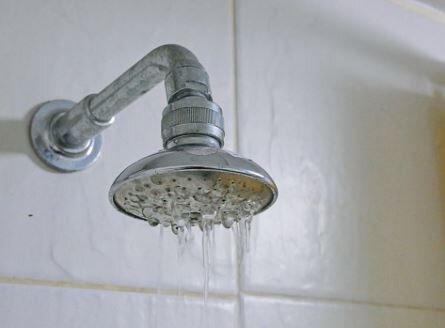If you’re experiencing fluctuation in shower water pressure, don’t brush the issue off. The problem could be more severe than you imagine, potentially involving serious problems like leaking or cracked water pipes and may require professional intervention before snowballing into a home plumbing disaster.
The first step should be to test how much pressure you’re actually getting from the showerhead. A typical home’s water pressure should be somewhere between 45 to 55 psi (pounds per square inch). You can test the pressure by hooking up a simple pressure gauge to an outside spigot close to the main water supply line. The washing machine’s cold-water line is another good place to test household water pressure. Anything below 40 psi is considered low and generally indicates a problem with the water pressure coming into the house.
Sometimes, however, the problem is somewhere inside the house.
If your shower head pressure is abruptly dropped for no discernible reason, there’s a decent chance that your home’s water pressure regulator, which is typically set to maintain water pressure between 45-60 psi, may be malfunctioning. If this is the case, you may want to contact a trained technician.
Sudden decreases in shower head water pressure could also be attributed to accidental shutoff of your home water valves, which are the main control valves of water into your home, typically located in a home’s water meter box. To resolve this relatively minor issue, locate your home water valve and make sure it is completely set on the “ON” position. Even slight or accidental “OFF” positioning can significantly alter home water pressure. The best thing about offset home water valves is that the issue is extremely simple to fix.
Sometimes, low water pressure from the shower heads is due to something entirely outside of your home and home’s plumbing system. If you frequently use your shower during peak periods, such as early in the morning or at night, there’s a chance the performance issue is due to high water use within your neighborhood or building. If you believe this is the case, test your water pressure at other low-use periods. This is when local water consumption would be lower than it is immediately before work hours or when residents in your community return home from work.
In older homes or those with outdated plumbing systems that heavily feature galvanized pipe, mineral accumulation (which develops over time) is a common cause of low shower pressure. Despite your best efforts, there’s little you can do on your own to avoid mineral deposits and accumulation over time. It’s also quite difficult to remove the mineral deposits within pipes on your own. In these cases, you should contact us right away to repair or replace your pipes.
Worst case scenario, you cannot identify the cause of your low shower water pressure with any other means, there’s a chance your low pressure is the direct result of pipe leaking or fracturing. As water escapes through these leaks, less and less of it will be able to reach your showerheads and other drain fixtures. If this is the case with your home plumbing system, there’s little you can do to resolve the issue other than contacting a trained professional. Our specialist will be able to fully evaluate the integrity of your pipes and use this knowledge to suggest the best possible repair solutions for your damaged plumbing.

